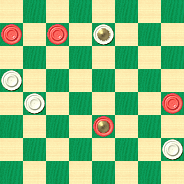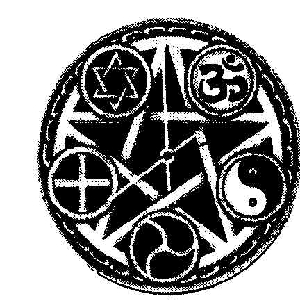Subtle

An image such as the one above, unusual though it may seem, is filled with deep and and often subtle symbolism and meaning, unraveled only through careful consideration and study.
Today's entry in our Checker School series demonstrates once more that checkers too can be deep and subtle, with each move having its own meaning and significance. The problem shown below, first published over 140 years ago, is definitely not easy, but by any measure it is rewarding, satisfying, and entertaining, and we might even say, enlightening.
BLACK

WHITE
White to Play and Draw
W:W28,17,13,K7:BK23,20,6,5.
Can you unravel the subtleties of this difficult position? Think deeply, and be careful of seemingly small nuances that loom large in the end. When you've unraveled the meaning of the problem, click on Read More to see the solution, sample games, and detailed explanatory notes.![]()
Solution
Lettered notes come from Ben Boland's classic Famous Positions in the Game of Checkers. Numbered notes are by the Editor using Ed Gilbert's KingsRow computer engine and 10-piece endgame database.
BLACK

WHITE
White to Play and Draw
W:W28,17,13,K7:BK23,20,6,5.
7-3, 23-19---1, 3-8---A, 19-15---B, 8-12*, 15-19, 12-8, 20-24, 8-3*---3, 24-27, 3-7---4, 27-32---C, 7-11, 32-27, 17-14, 27-32---5, 14-10. Drawn.
Game: 11-15, 22-17, 15-19, 24-15, 10-19, 23-16, 12-19, 25-22, 8-11, 30-25, 4-8, 22-18, 11-16, 27-23, 8-12, 18-15, 3-8, 17-13, 7-10, 25-22, 10-14, 31-27, 14-18, 23-14, 9-25, 29-22, 2-7, 27-23, 7-10, 32-27, 10-14, 22-17, 16-20, 23-16, 12-19, 17-10, 19-23, 26-19, 8-11, 15-8, 6-31, 8-3, 31-26, 3-7, 1-6, 21-17, 26-23. Forms above position. F. Allen.
Game: 9-14, 22-17, 11-16, 25-22, 8-11, 24-19, 11-15, 17-13, 15-24, 28-19, 4-8, 22-17, 8-11, 29-25, 16-20, 19-16, 12 19, 23-16, 11-15, 26-23, 6-9, 13-6, 2-9, 17-13, 1-6, 16-12, 14-17, 21-14, 9-18, 23-14, 10-17, 31-26, 17-21, 25-22, 6-10, 26-23, 7-11, 23-18, 15-19, 12-8, 3-12, 18-14, 10-26, 30-7, 21-25, 7-3, 25-30, 3-7, 30-26, 7-10, 12-16, 32-28. Forms above position, colors reversed. J. Ferrie vs. J. C. Brown, Scottish Tourney Book, 1896.
A---Corrects A. Anderson who played; 3-7---2, 19-16, 7-3, 16-11, 17-14 (Now No. 299 Lyman's Problem Book), 6-10, 14-7, 11-2, 3-8, 2-7, 8-12, 20-24, 28-19, 7-11, Black wins. MDyke" Game Anderson's First, 1848, and Second 1852 Editions.
B---19-16, 17-14, 16-18, 8-11, 19-16, 11-8*. Drawn.
C---19-23, 7-11, 23-18, 28-24,18-23, 24-20, 23-19, 11-7, 27-31, 7-11, 31-26, 11-7*, 26-22, 7-11, 22-25, 11-7*, 19-23, 20-16, 23-18, 16-12, 18-22, 12-8, 5-9, 7-2. Drawn.
1---The 20-24 exchange is no better for Black.
2---This distinction really illustrates for us the subtlety of checkers; 3-8 draws while 3-7 loses, yet to the layman's eye, the moves hardly seem to differ. Something like this certainly destroys the popular notion that checkers is easy or dull!
3---Another subtlety: 8-12 would lose. 8-3 is the only move to draw.
4---And now 3-7 draws while 3-8 loses!
5---Now Black has to watch out: 27-23 loses to the 14-10 6-15 11-27 shot, and 27-24 falls to 11-16 19-12 28-19 12-8 19-15 8-12 14-10 and Black loses a man. Note how the lone White man bullies the powerful Black king.
The above position by Fred Allen may be found as No. 13, Draughts Board, June 1, 1869, where it is given as a correction of Anderson's Dyke Game. It also is No. 210 Gould's Problem Book.
J. Wyllie in Gem No. 104 Draughts World, Vol. 7, Feb. 1896, pointed out how J. C. Brown could have won from J. Ferrie, who played 3-7 at A, as did Anderson. W. MacAdam also published same correction.

You can email the Webmaster with comments on this article.